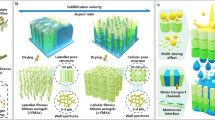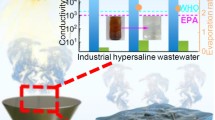Abstract
High-efficiency and low-cost solar-driven interfacial evaporation is a promising approach for seawater desalination on ships, islands, and offshore platforms. Thus far, various nanostructured interfacial evaporation materials have been developed, and chemical regulation, surface engineering, and other modification strategies have been applied. As a result, the evaporation rate of interfacial evaporation systems has significantly increased. However, interfacial evaporation materials still suffer from disadvantages such as high costs and complex preparation processes. Furthermore, nanostructured materials exhibit poor mechanical properties, which limit their practical applications. In this study, we prepared a hierarchical porous carbon fiber felt-reinforced carbon aerogel composite for interfacial evaporation applications. The composite exhibited low thermal conductivity, excellent mechanical properties, and high evaporation rates in both pure water and seawater under 1-sun illumination. Moreover, the composite maintained a stable evaporation rate and excellent cyclicity for a long period under 5-sun illumination in high-salinity seawater. The low cost of raw materials, simple preparation process, and short production cycle are beneficial for the large-scale production and application of this novel interfacial evaporation material.
Graphical Abstract

Highlights
-
The carbon aerogels prepared using the principle of acid-base two-step catalysis have a high specific surface area (596.367 m2g−1) and low thermal conductivity (0.0625 W/(m K)), which enable them to efficiently absorb sunlight and provide an excellent thermal insulation effect.
-
The difference in shrinkage between carbon fiber felts and carbon aerogels is ingeniously utilized, so the composites have micron-scale macropores and defects to provide channels for vapor escape.
-
Under 1-sun illumination, the evaporation rates of the composites reach 1.131 and 1.046 kg m−2 h−1 in pure water and seawater, respectively, with an evaporation efficiency of 81%.
-
Due to the composite reinforcement of the highly elastic carbon fiber felts, the composites are able to endure a stress of 25.6 MPa when the strain reaches 75%. The strategy of carbon fiber felts reinforcement not only enhances the mechanical properties and durability of the composite but also avoids the brittle fracture of pure carbon aerogels.
-
The obtained composites combine low-cost effectiveness with high mechanical properties and durability.





Similar content being viewed by others
References
Ghasemi H, Ni G, Marconnet AM, Loomis J, Yerci S, Miljkovic N, Chen G (2014) Solar steam generation by heat localization. Nat Commun 5(1):1–7. https://doi.org/10.1038/ncomms5449
Mito MT, Ma X, Albuflasa H, Davies PA (2019) Reverse osmosis (RO) membrane desalination driven by wind and solar photovoltaic (PV) energy: state of the art and challenges for large-scale implementation. Renew Sustain Energy Rev 112:669–685. https://doi.org/10.1016/j.rser.2019.06.008
Loutatidou S, Arafat HA (2015) Techno-economic analysis of MED and RO desalination powered by low-enthalpy geothermal energy. Desalination 365:277–292. https://doi.org/10.1016/j.desal.2015.03.010
Assiri M, Antar MA, Hamed O, Lawal DU (2021) Performance improvement of multi‐stage flash desalination with thermal vapor compression, a practical consideration. Int J Energy Res 45(15):20651–20671. https://doi.org/10.1002/er.7131
Tao P, Ni G, Song C, Shang W, Wu J, Zhu J, Chen G, Deng T (2018) Solar-driven interfacial evaporation. Nat Energy 3(12):31031–31041. https://doi.org/10.1038/s41560-018-0260-7
Zhu M, Li Y, Chen F, Zhu X, Dai J Y, Li, Yang Z, Yang X, Song J, Wang Y, Hitz E, Luo W, Lu M, Yang B, Hu L (2018) Plasmonic wood for high-efficiency solar steam generation. Adv Energy Mater 8(4):1701028. https://doi.org/10.1002/aenm.201701028
Wang J, Li Y, Deng L, Wei N, Weng Y, Dong S, Qi D, Qiu J, Chen X, Wu T (2017) High-performance photothermal conversion of narrow-bandgap Ti2O3 nanoparticles. Adv Mater 29(3):1603730. https://doi.org/10.1002/adma.201603730
He J, Liu F, Xiao C, Sun H, Li J, Zhu Z, Liang W, Li A (2021) Fe3O4/PPy-coated superhydrophilic polymer porous foam: a double layered photothermal material with a synergistic light-to-thermal conversion effect toward desalination. Langmuir 37(42):12397–12408. https://doi.org/10.1021/acs.langmuir.1c02013
Dong S, Zhao Y, Yang J, Li W, Luo W, Li S, Liu X, Guo H, Yu C, Sun J, Feng J, Zhu Y (2022) Solar water recycling of carbonaceous aerogel in open and colsed systems for seawater desalination and wastewater purification. Chem Eng J 431:133824. https://doi.org/10.1016/j.cej.2021.133824
Hu X, Xu W, Zhou L, Tan Y, Wang Y, Zhu S, Zhu J (2017) Tailoring graphene oxide-based aerogels for efficient solar steam generation under one sun. Adv Mater 29(5):1604031. https://doi.org/10.1002/adma.201604031
Li L, Hu T, Li A, Zhang J (2020) Electrically conductive carbon aerogels with high salt-resistance for efficient solar-driven interfacial evaporation. ACS Appl Mater Interfaces 12(28):32143–32153. https://doi.org/10.1021/acsami.0c06836
Li T, Fang Q, Wang J, Lin H, Han Q, Wang P, Liu F (2021) Exceptional interfacial solar evaporation via heteromorphic PTFE/CNT hollow fiber arrays. J Mater Chem A 9(1):390–399. https://doi.org/10.1039/D0TA09368H
Wiener M, Reichenauer G, Braxmeier S, Hemberger F, Ebert HP (2009) Carbon aerogel-based high-temperature thermal insulation. Int J Thermophys 30(4):1372–1385. https://doi.org/10.1007/s10765-009-0595-1
Dukovic G, Wang F, Song D, Sfeir MY, Heinz TF, Brus LE (2005) Structural dependence of excitonic optical transitions and band-gap energies in carbon nanotubes. Nano Lett 5(11):2314–2318. https://doi.org/10.1021/nl0518122
He W, Zhou L, Wang M, Cao Y, Chen X, Hou X (2021) Structure development of carbon-based solar-driven water evaporation systems. Sci Bull 66(14):1472–1483. https://doi.org/10.1016/j.scib.2021.02.014
Wang H, Du A, Ji X, Zhang C, Zhou B, Zhang Z, Shen J (2019) Enhanced photothermal conversion by hot-electron effect in ultrablack carbon aerogel for solar steam generation. ACS Appl Mater Interfaces 11(45):42057–42065. https://doi.org/10.1021/acsami.9b12918
Guo P, Li J, Pang S, Hu C, Tang S, Cheng H (2021) Ultralight carbon fiber felt reinforced monolithic carbon aerogel composites with excellent thermal insulation performance. Carbon 183:525–529. https://doi.org/10.1016/j.carbon.2021.07.027
Fu Y, Wang G, Mei T, Li J, Wang J, Wang X (2017) Accessible graphene aerogel for efficiently harvesting solar energy. ACS Sustain Chem Eng 5(6):4665–4671. https://doi.org/10.1021/acssuschemeng.6b03207
Yin Z, Wang H, Jian M, Li Y, Xia K, Zhang M, Wang C, Wang Q, Ma M, Zheng Q, Zhang Y (2017) Extremely black vertically aligned carbon nanotube arrays for solar steam generation. ACS Appl Mater Interfaces 9(34):28596–28603. https://doi.org/10.1021/acsami.7b08619
Kéri M, Nyul D, LászlóK, Novák L, Bányai I (2022) Interaction of resorcinol-formaldehyde carbon aerogels with water: a comprehensive NMR study. Carbon 189:57–70. https://doi.org/10.1016/j.carbon.2021.12.045
Zhang Z, Zhao S, Chen G, Feng J, Feng J, Yang Z (2020) Influence of acid-base catalysis on the textural and thermal properties of carbon aerogel monoliths. Microporous Mesoporous Mater 296:109997. https://doi.org/10.1016/j.micromeso.2019.109997
Berthomieu C, Hienerwadel R (2009) Fourier transform infrared (FTIR) spectroscopy. Photosynth Res 101(2):157–170. https://doi.org/10.1007/s11120-009-9439-x
Dong S, Zhao Y, Yang J, Liu X, Li W, Zhang L, Wu Y, Sun J, Feng J, Zhu Y (2021) Visible-light responsive PDI/rGO composite film for the photothermal catalytic degradation of antibiotic wastewater and interfacial water evaporation. Appl Catal, B 291:120127. https://doi.org/10.1016/j.apcatb.2021.120127
Ţucureanu V, Matei A, Avram AM (2016) FTIR spectroscopy for carbon family study. Crit Rev Anal Chem 46(6):502–520. https://doi.org/10.1080/10408347.2016.1157013
Mohsenpour M, Motahari S, Tajabadi F, Zajafi M (2020) Preparation and application of sunlight absorbing ultra-black carbon aerogel/graphene oxide membrane for solar steam generation systems. RSC Adv 10(68):41780–41790. https://doi.org/10.1039/D0RA07522A
Reuß M, Ratke L (2008) Subcritically dried RF-aerogels catalysed by hydrochloric acid. J Sol-Gel Sci Technol 47(1):74–80. https://doi.org/10.1007/s10971-008-1733-0
Yan MF, Zhang LH, He R, Liu Z (2015) Synthesis and characterization of carbon aerogels with different catalysts. J Porous Mater 22(3):699–703. https://doi.org/10.1007/s10934-015-9942-8
Han S, Sun Q, Zheng H, Li J, Jin C (2016) Green and facile fabrication of carbon aerogels from cellulose-based waste newspaper for solving organic pollution. Carbohydr Polym 136:95–100. https://doi.org/10.1016/j.carbpol.2015.09.024
Du J, Li WC, Ren ZX, Guo LP, Lu AH (2020) Synthesis of mechanically robust porous carbon monoliths for CO2 adsorption and separation. J Energy Chem 42:56–61. https://doi.org/10.1016/j.jechem.2019.06.006
Liu H, Wang P, Yuan W, Li H (2021) Study on the thermal insulation performance of the core–shell skeleton graphene oxide/carbon composite aerogel. J Polym Eng 41(10):863–872. https://doi.org/10.1515/polyeng-2021-0109
Sethia G, Sayari A (2016) Activated carbon with optimum pore size distribution for hydrogen storage. Carbon 99:289–294. https://doi.org/10.1016/j.carbon.2015.12.032
Aim SE, Jacques AY, Albert T (2013) N-doped carbon aerogels for carbon dioxide (CO2) capture. Afr J Pure Appl Chem 7(2):61–66. https://doi.org/10.5897/AJPAC2013.0481
Chen L, Yu H, Li Z, Chen X, Zhou W (2021) Cellulose nanofiber derived carbon aerogel with 3D multiscale pore architecture for high-performance supercapacitors. Nanoscale 13(42):17837–17845. https://doi.org/10.1039/D1NR04838D
Ma Y (2022) Carbon aerogel from waste corrugated cardboard: facile preparation, characterization, and application to solar steam generation and adsorption. Korean J Chem Eng 39:1775–1787. https://doi.org/10.1007/s11814-022-1137-9
Alipour M, Massoudinejad M, Sanaei D, Rasoulzadeh H, Hadei M (2021) Design and synthesis of two novel carbon aerogels using citric and tartaric acids as catalysts for continuous water desalination. Desalin Water Treat 215:69–79. https://doi.org/10.5004/dwt.2021.26809
Yin J, Song K, Lu Y, Zhao G, Yin Y (2015) Comparison of changes in micropores and mesopores in the wood cell walls of sapwood and heartwood. Wood Sci Technol 49(5):987–1001. https://doi.org/10.1007/s00226-015-0741-9
Wu K, Dong W, Pan Y, Cao J, Zhang Y, Long D (2021) Lightweight and flexible phenolic aerogels with three-dimensional foam reinforcement for acoustic and thermal insulation. Ind Eng Chem Res 60(3):1241–1249. https://doi.org/10.1021/acs.iecr.0c05010
Chen G, Jiang Z, Li A, Chen X, Ma Z, Song H (2021) Cu-based MOF-derived porous carbon with highly efficient photothermal conversion performance for solar steam evaporation. J Mater Chem A 9(31):16805–16813. https://doi.org/10.1039/D1TA03695E
Huo B, Jiang D, Cao X, Liang H, Liu Z, Li C, Liu J (2019) N-doped graphene/carbon hybrid aerogels for efficient solar steam generation. Carbon 142:13–19. https://doi.org/10.1016/j.carbon.2018.10.008
Han S, Ruoko TP, Gladisch J, Erlandsson J, Wågberg L, Crispin X, Fabiano S (2020) Cellulose-conducting polymer aerogels for efficient solar steam generation. Adv Sustain Syst 4(7):2000004. https://doi.org/10.1002/adsu.202000004
Acknowledgements
The work was financially supported by the National Natural Science Foundation of China (Grant no. 51802347). Thanks to eceshi (www.eceshi.com) for the XRD analysis and Shiyanjia (www.shiyanjia.com) for the SEM test.
Author information
Authors and Affiliations
Corresponding authors
Ethics declarations
Conflict of interest
The authors declare no competing interests.
Additional information
Publisher’s note Springer Nature remains neutral with regard to jurisdictional claims in published maps and institutional affiliations.
Rights and permissions
Springer Nature or its licensor (e.g. a society or other partner) holds exclusive rights to this article under a publishing agreement with the author(s) or other rightsholder(s); author self-archiving of the accepted manuscript version of this article is solely governed by the terms of such publishing agreement and applicable law.
About this article
Cite this article
Gan, Z., Zhao, S., Zhang, Z. et al. Hierarchically porous and high-strength carbon aerogel-based composite for solar-driven interfacial evaporation. J Sol-Gel Sci Technol 107, 388–400 (2023). https://doi.org/10.1007/s10971-023-06119-5
Received:
Accepted:
Published:
Issue Date:
DOI: https://doi.org/10.1007/s10971-023-06119-5




